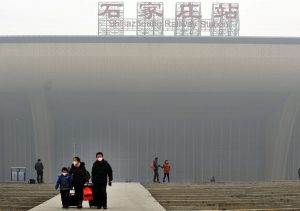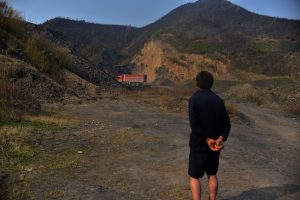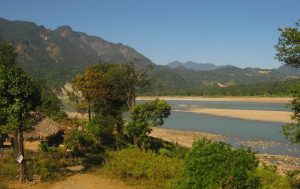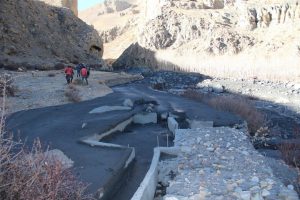Three years into Premier Li Keqiang’s declared “war on pollution,” and this winter’s smog is taking a new turn. On the one hand, statistics show that overall air quality in China has improved; on the other, a growing gap in air quality between China’s east coast and its inland cities has tensions flaring.
In Chengdu, the city of 14 million people in central Sichuan province, the exceptionally poor air has become unbearable. Thick fog and smog closed runways at Shuangliu International Airport for 14 hours in December, resulting in morning cancellations that stranded 20,000 travellers.
That month, Chengdu experienced nine days of sustained air pollution, bringing media outlets to report on rising outcry from residents. According to the Sixth Tone, police clashed with a group of artists at an air pollution protest.
Around 600 kilometres away, in the large western city of Xi’an, another group of artists led an avant-garde protest following nearly a week of continuous smog. Putting their creativity into practice, students at the Xi’an Academy of Fine Arts affixed face masks to a stand of stone lions, turning the bad air into part of an art installation.
Perhaps more than the air pollution itself, residents of western cities are infuriated by the weak response from local governments. Beijing-Tianjin-Hebei (also known as Jing-Jin-Ji), being the region most closely associated with smog, is putting forward ever stronger measures to combat the problem.
Far-reaching, regional, emergency air pollution response measures linking Beijing, Tianjin, Hebei, Henan and Shandong are now in place. Earlier this year, Shijiazhuang simply shut down industrial production for a month-and-a-half in order to meet air quality standards. The difference in government response between these eastern cities and China’s western urban centers has been striking.
Development and pollution
The differences between smog response measures in Beijing and Chengdu are a case in point. The pollution conditions triggering a level-three (yellow) alert in Chengdu are basically identical to the triggers for a level-two (orange) alert in Beijing. This implies that under similar pollution conditions, mitigation measures in Chengdu will be weaker than in Beijing.
Chengdu’s economic development model is also facing criticism.
Data source: chengdu.gov.cn (Click on ring to see percentages)
At its core, Chengdu’s pollution problem is bound up in the structure of the economy. In 2015, the city’s Air Pollution Sources Analysis showed that the top three sources of PM2.5 were transportation, coal-burning and dust – each accounting for over 20% of the total. Although direct emissions from industry account for only 6%, heavy industrial plants like steelworks are big coal consumers, meaning that large-scale industrial production both directly and indirectly causes significant air pollution.
The local economy’s overreliance on real estate development and infrastructure projects have added to Chengdu’s environmental burden. Data from the National Bureau of Statistics website show that in 2014, real estate development sites in Chengdu covered 170 million square metres, overtaking both Beijing and Shanghai.
By comparison, development projects only occupied 20 million square metres in 2002. Chengdu is transforming into one big, dusty construction site, and this dustiness is a major source of particulate matter.
Chengdu’s traffic regulations are an even more direct source of air pollution. While the odds of winning Beijing’s license plate lottery have dwindled to virtually nil, Chengdu residents still face no restrictions when buying a car. In 2013, rates of vehicle ownership in Chengdu were second only behind Beijing, and they continue to rise at an astounding rate: car ownership doubled between 2013 and 2016.
According to media reports, Chengdu currently has 4.64 million vehicles on the road, which contribute half of the city’s nitrogen oxide emissions. In hot weather, nitrogen oxide produces ozone, which in high concentrations can cause respiratory inflammation, nerve damage, dizziness, and headaches.
Cities in eastern China have responded to environmental bottlenecks by carefully limiting development. In Beijing, Tianjin, Hebei, Henan, and Shandong, coal consumption is controlled, steel and cement producers have been forced to cut capacity, and factories must sometimes shut down on smoggy days. The old high-pollution industrial economic model is now facing serious challenges.
Out of time in China’s “other cities”
It is important to note that the strength of atmospheric pollution regulations varies by place in China. In September 2013, the State Council released ten regulations setting higher air quality targets for Beijing-Tianjin-Hebei, the Yangzte River Delta, and the Pearl River Delta (all the in the east of the country), relative to the rest of the country. By 2017, the Beijing-Tianjin-Hebei region is mandated to reduce PM2.5 levels by 25% relative to 2013 levels, while other cities need only to reduce levels by 10% (in the two deltas the target is 15%).
These three dense urban regions, which have the highest GDP in China, are closely bound to high pollution sources. Yet the pollution management challenges facing other regions in China are no less daunting. According to a Greenpeace East Asia analysis of air quality data from 362 Chinese cities in the first quarter of 2016, of the 91 cities which experienced worsening air pollution, two-thirds of them were located in central or western China – namely, the “other cities” outside of the three key eastern regions.
Compared to the relatively strict smog-control regulations in eastern cities, actions taken by central and western Chinese cities have been slow-coming. One reason for this trend, according to Greenpeace East Asia climate and energy campaigner Dong Liansai, is that governments in eastern regions have forced heavy polluting industries like coal-fired power plants and chemical factories to move elsewhere.
China’s western provinces, which seek new investment to propel economic development, have welcomed these companies with open arms: in 2015, three-quarters of the country’s 210 newly-approved, coal-fired power plants were slated to be built in central or western China.
But for these “other cities,” the grace period to deal with air pollution is coming to a close. The recently-published 13th Five-Year Plan for Eco-Environmental Protection has set clear targets for cities not yet in line with air quality standards, which includes perhaps 78% of Chinese cities. By 2020, these cities must achieve an 18% improvement in air quality relative to current levels.
At present, average annual air pollution is slightly better in Chengdu than Beijing. In 2015, the average concentration of PM2.5 in Chengdu was 61 micrograms per cubic metre, compared to Beijing’s 81 micrograms per cubic metre. But no matter whether or not Beijing reaches its target of 60 micrograms per cubic meter by 2017, the relatively clean air enjoyed by residents in Chengdu and other western cities – if it can be called that – is likely to become worse.
And clearly, as residents of western cities become more environmentally aware, their patience for poor air and poor environmental governance will soon run out.





![[:en]ٹھنڈیانی روڈ، ایبٹ آباد کے قریب پتھر پیسنے کا ایک منظر ( تصویر- محمّد زبیر خان )[:ne]ٹھنڈیانی روڈ، ایبٹ آباد کے قریب پتھر پیسنے کا ایک منظر ( تصویر- محمّد زبیر خان )[:hi]ٹھنڈیانی روڈ، ایبٹ آباد کے قریب پتھر پیسنے کا ایک منظر ( تصویر- محمّد زبیر خان )[:bn]ٹھنڈیانی روڈ، ایبٹ آباد کے قریب پتھر پیسنے کا ایک منظر ( تصویر- محمّد زبیر خان )[:]](https://dialogue.earth/content/uploads/2017/01/Crushers-working-on-Thandiani-road-Abbottabad-300x225.jpg)


